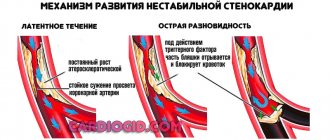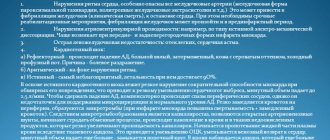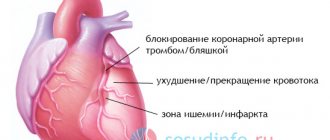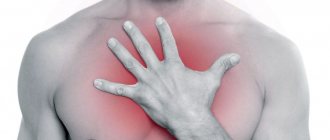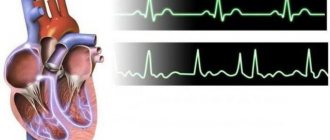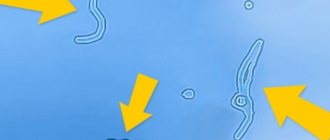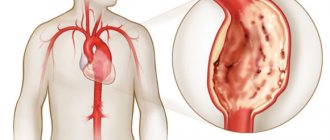Angina pectoris is a type of chronic coronary insufficiency during which there is a disturbance in the speed and nature of blood flow in the heart.
Ischemia (oxygen starvation) leads to the gradual death of normal anatomical structures, myocyte cells and their replacement with connective or scar tissue.
The second name of the pathological process is angina pectoris. The condition is not called angina pectoris lightly. The disease occurs in attacks.
Each such episode is accompanied by painful sensations. Pain and heaviness are associated with intense exposure from the inside.
Treatment has good prospects as long as pronounced anatomical changes (for example, cardioclerosis) have not developed. The essence is to eliminate the root cause of the condition, normalize the patient’s well-being and prevent further progression.
The possibility of total etiotropic treatment is associated with a better prognosis.
Without therapy, myocardial contractility decreases, ischemia and hypoxia of all body tissues occur. Complications are inevitable. Therefore, at the first suspicious symptoms, it is recommended to contact a specialist.
Development mechanism
The essence of the pathological process is a disruption of the normal blood flow through the coronary arteries.
In the vast majority of cases, this is observed against the background of atherosclerosis.
There is a blockage of the structure with a cholesterol plaque, radially, along the entire diameter. Patency decreases, making it more difficult for blood to overcome resistance.
The intensity of movement of liquid connective tissue decreases significantly. The compensatory mechanism is an increase in blood pressure, but this makes no sense. On the contrary, the condition only gets worse due to increased load on the myocardium and all blood vessels.
The next pathogenetic stage is the beginning of the death of cardiomyocyte cells as a result of insufficient nutrition. In their place, scar tissue grows, acting as a kind of plug.
This is a constantly recurring process that occurs in paroxysms. Episodes of angina pectoris are manifested by severe pain and discomfort in the sternum.
As the disease moves forward, severe heart failure occurs, and then a heart attack, which often puts an end to the patient’s life.
Avoiding such a scenario is the task of early therapy.
Causes and manifestations
The cause of this cardiovascular disease is vascular pathology:
- deposition of atherosclerotic plaques on the walls of blood vessels;
- vasospasm.
Most often, doctors diagnose both causes. An attack can be triggered by:
- stress;
- physical stress;
- emotional stress;
- overweight and love of sweets;
- alcohol and nicotine abuse;
- diseases of the gastrointestinal tract;
- bloating or a high-standing diaphragm.
Symptoms of angina pectoris are a picture of a heart attack. But before the patient feels all the “beauty” of angina pectoris, he will notice the preceding symptoms:
- shortness of breath and discomfort in the heart after exercise;
- chest pain that occurs after stress or excitement;
- pain behind the sternum, which can spread into the interscapular space.
Particularly dangerous are attacks of pain that occur in the patient during sleep. As the patients themselves say, they wake up from pain in the sternum, dizziness, and fear of death. Usually, fear after such attacks remains in the patient’s memory for a long time.
Objectively, the following symptoms indicate an attack:
- pale skin;
- sweat on the face and body;
- pointed facial features;
- frequent urination and vomiting;
- increased blood pressure;
- bradycardia or tachycardia;
- fear of death.
In most cases, the disease is chronic, with exacerbations followed by remissions. But when the first signs of the disease appear, it is necessary to seek qualified help, because the disease can progress and be complicated by myocardial infarction, cardiosclerosis or heart failure.
Classification
It is carried out according to a group of criteria.
Based on the nature of development:
- Stable angina pectoris or angina pectoris. It tends to spontaneously stop progressing. At a certain point, the process stagnates, stops and stops moving forward. This is optimistic and provides an opportunity for high-quality diagnosis and selection of competent treatment tactics
- Unstable variety. Progresses constantly, each attack leads to aggravation of the pathological process. The movement of the disease is not always uniform. Spasmodic development is possible.
Depending on the type and provocateur of the episode:
- Angina pectoris or exertional angina. Formed against the background of intense physical or emotional overload. If prevention measures are followed, there is a good chance of slowing down the pathological process. Recovery is carried out in a hospital, as planned. Then outpatient.
- Angina at rest. Attacks occur without connection with an overload of the body. Considered a more dangerous type.
In relation to the described process, subdivision by stage is possible. In the case of a disease of this type, they talk about functional classes:
| Class | Characteristic |
| 1 FC | Almost invisible to the patient. Provoking attacks requires intense physical activity. |
| 2 FC | Symptoms develop against a background of significant activity. It is also a relatively mild form, but cannot be completely cured. With properly selected therapy, there is every chance of not remembering the disease at all. |
| 3 FC | Episodes appear against the background of moderate load. The patient cannot climb 3-4 floors. |
| 4 FC | Minimal activity is not possible. Symptoms manifest themselves even at complete rest. Walking and slight movement have a negative impact. |
Causes
Factors in the development of the pathogenic process can be divided into two groups. The first concerns the fundamental issues that determine the beginning of change.
Atherosclerosis
The most active factor. Becomes the culprit of angina pectoris in 90% of cases or so. The essence of the pathological process is dual; it is a heterogeneous group of conditions.
The first clinical variant has already been named. Partial blockage of the lumen of a coronary vessel by a cholesterol plaque. Lipid structures form such formations as a result of metabolic disorders.
The blood is not able to overcome the resistance of the altered artery, ischemia occurs, which progresses as atherosclerosis develops.
The second clinical option is stenosis or narrowing of the lumen. It has a multifactorial origin and can also be associated with metabolic processes in the body. Or inflammatory pathologies. Here the scope for diagnostic research is much wider.
Regardless of the option, the essence is the same. Myocardial malnutrition, ischemia, death: first slow and smooth (the actual attacks of angina pectoris indicate such episodes), then avalanche-like (heart attack). Both conditions described are types of coronary insufficiency.
Vasculitis
It is also inflammation of the walls of blood vessels, in particular the arteries that supply the heart muscle. Autoimmune types of pathological process are more common. Isolated ones are relatively rare.
The variant with involvement in a complex disease is much more widespread. Which one exactly needs to be clarified. Viral and generally infectious varieties are also possible, but are much less common, always have a secondary nature, and occur against the background of reduced immunity.
In this case, angina pectoris develops as a result of scarring of the affected vascular walls. Areas of rough epithelialization appear. The altered areas prevent blood from moving normally.
Such anatomical defects require surgical treatment. The point is to cut abnormal structures or make prosthetics. Success depends on the extent of the pathological process. The prognosis is generally favorable if no major changes occur.
Abnormal development of the coronary arteries
In this case, we are talking about genetic pathologies that occur mainly in boys or about some kind of intrauterine development failure.
The perinatal period is especially responsible in the first trimester. Then everything runs more smoothly. In the case of an isolated defect of vascular structures, surgery to correct the pathological condition is indicated. The type of intervention is determined based on the severity of the changes.
In the case of genetic syndromes, coronary artery anomalies are not isolated. More often they are combined with defects of the myocardium itself, the mitral, aortic valve, septum, other structures, vessels in general, remote organs and systems.
Treatment is very difficult and gives vague prognoses.
Hypertrophic cardiomyomaty
“Bull's heart” and other severe conditions, which are typically characterized by an increase in the size of the muscular organ as a whole. Compression of the coronary arteries occurs.
The mass effect produced prevents adequate blood flow. Surgery can be a solution, but not always. If cardiac structures are significantly altered, organ transplantation is indicated. Even this does not guarantee survival. Read more about hypertrophic cardiomyopathy in this article.
Angina pectoris symptoms and treatment with folk remedies
Angina pectoris (angina pectoris) is a spasm of the artery that does not allow blood to pass through, causing the patient to be deprived of the flow of oxygen and can die very quickly. This disease can appear as a result of severe physical or mental stress, especially with a diseased heart. The presence of diabetes predisposes you to angina pectoris. During an attack, the patient feels severe pain, a burning sensation in the pit of the stomach, and excruciating fear. Read more about the symptoms of angina here.
Emergency care for angina and acute myocardial infarction
1. Calm the patient and those around him, sit or lay the patient down (ensure physical and mental peace).
2. Give 1-2 tablets of nitroglycerin under the tongue. If necessary, give nitroglycerin again every 15 minutes. Headaches and noise in the head may occur.
3. Introduce analgin 50% - 2 ml or Tramal - 2 ml intramuscularly, or better yet immediately intravenously with 10-20 ml of 0.9% sodium chloride solution.
4. If the pain is not relieved, narcotic analgesics should be administered intravenously: morphine hydrochloride 1% - 1 ml, omnopon 1-2% - 1 ml, or promedol 1-2% - 1 ml per 10-20 ml 0.9% sodium chloride solution.
5. If the pain remains severe, fentanyl 0.005% - 2 ml (with sodium chloride) is administered intravenously. Fentanyl has the most powerful, but short-term (with intravenous administration - up to 30 minutes) analgesic effect.
6. Simultaneously with narcotic or non-narcotic analgesics, diphenhydramine 1% - 1 ml or seduxen (Relanium) - 2 ml can be administered intramuscularly or intravenously. They enhance the effect of analgesics and have a sedative effect.
7. Antispasmodics and antihypertensive drugs (papaverine, no-shpu, dibazol, magnesium sulfate, etc.) should be administered only if blood pressure significantly exceeds the patient’s working blood pressure, since most drugs used in the treatment of angina and myocardial infarction have hypotensive effect. A sharp and significant decrease in blood pressure can aggravate the patient's condition.
8. It is advisable to carry out oxygen therapy using oxygen devices.
9. Hospitalization of patients with angina pectoris should be carried out on a stretcher in the therapeutic department of the hospital, and patients with new and progressive angina pectoris should be hospitalized in the cardiology department.
10. To hospitalize a patient with acute myocardial infarction without complications, you should call a medical team, and if this is not possible, hospitalize him in the cardiology department (on a stretcher).
11. Hospitalization of patients with acute myocardial infarction with complications (cardiogenic shock, pulmonary edema) is carried out only by a cardiology or medical team.
12. If the patient refuses hospitalization, an active call should be transmitted:
• in the case of stable angina in a chronic patient - to the local doctor of the clinic;
• in case of progressive or new angina and myocardial infarction - to the cardiology ambulance team, which should wait at the patient’s bedside.
13. In all doubtful cases, the principle of overdiagnosis should be observed in the interests of the patient.
14. Drugs that increase myocardial oxygen demand (aminophylline, platyphylline) are contraindicated, and cardiac glycosides (stofantin, corglycone, digoxin) are also contraindicated in patients with acute myocardial infarction or suspected of it.
The following forms of cardiogenic shock are distinguished:
• reflex – occurs at the height of a painful attack and passes after its relief;
• arrhythmic - occurs as a result of a sharp decrease in cardiac output due to acute cardiac arrhythmias (see the corresponding section);
• true cardiogenic shock - caused by a sharp decrease in myocardial contractility as a result of the extensive spread of the necrosis zone, and is the most dangerous complication.
• if you have a seizure, you should put mustard plaster on your heart and dry jars on your back.
If possible, lie still, then the pain will subside and the attack will lose its threatening character.
It is good to take vitamin B15,
as well as
eat plenty of ox liver and drink fresh ox blood.
Such patients should not smoke, as nicotine narrows the arteries.
These are the recommendations of Dr. O. Morozova,
summarizing the experience of old healers and healers.
Traditional medicine recipes:
1. Hawthorn tincture - 20-30 drops 3-4 times a day before meals. Prepared with 70% alcohol concentration 1:10.
2. Liquid extract of hawthorn - 20-30 drops 3-4 times a day.
5 g of hawthorn flowers are poured into 200 ml of hot boiling water, covered with a lid, heated in a water bath for 15 minutes, cooled for 45 minutes. Strain, squeeze and
bring the volume to 200 ml. Drink this infusion 1/2 cup 2-3 times a day for 30 minutes. before meals.
The infusion of fruits is prepared in the same way, but instead of flowers, 15 g of crushed fruits are taken per glass of water. Take 1/2-1/3 cup 2-3 times a day for 30 minutes. before meals.
3. For metabolic disorders, hypertension, angina pectoris, heart attack, stroke, the Tibetan manuscript recommends 1
Once every 3-5 years, carry out a course of treatment as follows.
Prepare a collection of 100 g of each: chamomile flowers, St. John's wort herb, immortelle flowers, birch buds.
Mix everything and chop finely, store in a glass jar with a lid. Prepare the daily dose in the evening, for which 1 tablespoon of the mixture is brewed with 0.5 liters of boiling water and left for 20 minutes. Then filter through linen and squeeze out the remainder. Immediately drink half of the infusion with 1 teaspoon of honey. In the morning, heat the remainder to 30-40 degrees and drink within 20 minutes. before meals. Treatment is carried out daily until the mixture is completely used.
Taking this collection cleanses the body of fat and lime deposits, headaches disappear, and the body rejuvenates.
4. For angina pectoris, menthol with valerian tincture is used to dilate blood vessels.
5. Pumpkin seeds relieve pain from angina pectoris and other cardiovascular diseases.
6. Copper has a good effect on the cardiovascular system .
If the heart hurts, then coins or disks are placed in the subclavian fossa
and
secured there. Usually the pain goes away after 10 days.
Russian doctor P. M. Kurennoye
for angina pectoris recommends:
A very valuable Russian folk recipe for shortness of breath and angina pectoris
This recipe often cures such decrepit old people who cannot walk 50 steps without stopping to rest.
Recipe. Take one liter of honey, squeeze 10 lemons, 10 heads of garlic
peel (whole heads, not cloves) and grind the garlic in a meat grinder. Mix all this together and leave it in a closed jar for a week. Drink 4 teaspoons every day, once a day. Exactly 4 spoons, but do not swallow everything at once, and take your time, slowly consume one spoon after another. Don't miss a day. This amount should be enough for two months.
Treatment with cupping
Treatment requires special jars with a rounded bottom and thick edges.
Banks are placed in areas with a well-developed muscle and fat layer. First, the place where the jars are placed should be smeared with Vaseline, a burning alcohol cotton wool should be placed in each jar for 2 seconds and quickly applied to the back for 5 minutes. You can remove the jar by lightly pressing on the skin around it.
Mud therapy
Take therapeutic mud baths with water temperature from 34 to 37 °C for 10 minutes.
Treatment with oils
Rub 5-6 drops of fir oil onto the area of the coronary vessels (below the nipple) 3-4 times a day.
This recipe is in the form of a letter from an intelligent person.
Preface to the letter.
Among the hundreds of thousands of Russian emigrants, unfortunate sufferers of angina pectoris and some other heart diseases, consuming nitroglycerin, there was one person “with a brain” who showed the fallacy of using nitroglycerin and recommending the old, but ever-new method of treatment with medicinal herbal preparations.
Here is the content of this wonderful letter:
“All my life I was a gymnast, a falcon, an athlete and as such I had one hundred percent health. Have you ever wondered what makes me sick?
Three years ago, I was suddenly attacked by angina pectoris, attacked in such a way, with such inhuman pain that I was paralyzed, afraid to move! The doctors assured that it was incurable, and advised to quit work, refuse any activity, etc. live with nitroglycerin!
I didn’t believe this, I turned to herbs, found hawthorn crategus and began drinking its infusion three glasses a day. After six months of gradual improvement, I completely forgot about nitroglycerin, and now I am as healthy as ever, and at 73 years old I work a full eight hours a day in a factory and do community service in the evenings. I drive a car, sometimes a hundred miles a day without stopping, and walk freely on stairs. Now you know why I need hawthorn, and I need rose hips as vitamin C, as a seasoning for hawthorn, to make it more pleasant to drink.
I prepare the hawthorn infusion like this: I have a saucepan for 7 glasses, I put 7 tablespoons of berries in it (spoons with a “hump”) and pour boiling water over it, put the pan on a non-heat-conducting stand (not a heat-conducting stand - an asbestos sheet of any thickness) , I wrap the pan warmly and keep it like that for about 20 or 24 hours. Then I strain the contents through a cloth, squeeze out the swollen berries and put the juice in the refrigerator. I drink a glass three times a day, with meals. When I began to be treated with herbs, I used hawthorn and motherwort in equal proportions by weight, and six months ago I started using only hawthorn and, frankly speaking, I don’t see much of a difference.
At my age, vitamin C is necessary, and, of course, you can just buy tablets, but I am a fan of natural remedies and therefore I prefer to brew hawthorn with rose hips, and it’s more pleasant to drink.
Very valuable note, comparison and difference.
Nitroglycerin only calms, and herbs heal. At the first sign of palpitations (even before the attack), you should switch to treatment with hawthorn infusion or hawthorn in half with the core. “Prevention is better than cure,” says Eastern wisdom. With nitroglycerin, after the first attack there is soon a second, and often a third. When treated with herbs (if treatment is started before the first seizure), this initial seizure does not occur for many years. If treatment is started after the first seizure, the second one is delayed for many years. Remember and do not forget that with nitroglycerin, doctors prescribe to give up all physical activity, and with herbal treatment, a person at 70-75 years old can engage in physical labor for eight or more hours a day and not have any heartbeat for many years and can walk freely on stairs.
Reading a letter from an intelligent person, many will not notice an element of colossal value, that is, the fact that an intelligent person decided to rise, as if on an aerial carpet, on two elements: a long rest and. The best medicine in the world for angina pectoris is an infusion of hawthorn berries. Let's take a whole group of patients with angina pectoris. Out of 100 people, 99 would not follow the principle of an intelligent person, since they would turn out to be “people with... hot livers” and after two to three weeks, feeling a noticeable improvement in health.
Trigger factors
The second group of factors are trigger points. If fundamental reasons determine the very possibility of the onset of angina pectoris, these provoke repeated attacks.
- Obesity. There are many myths around increased body weight. No, it is not actually excess weight that causes changes in normal blood flow. It's about a deep moment. Almost all obese people suffer from lipid metabolism disorders. Hence atherosclerosis and constant attacks of angina pectoris.
- Smoking. The results of tobacco consumption depend not so much on the duration and experience, but on the body’s resistance to toxic substances. As evidenced by scientific research in this area, resistance is genetically determined. For some, a year of smoking and a “drop of nicotine” is enough. For others, even a bucket is not enough to develop coronary artery stenosis. At some point, the body will still fail and the pathological process will begin. In advanced stages of angina pectoris, each use of tobacco leads to an attack.
- Caffeine addiction. The tonic effect also has a downside. There is a persistent narrowing of the coronary arteries with the impossibility of normal blood flow. Therefore, persons with diagnosed cardiac or vascular pathologies should not consume such drinks. This is fraught.
- Alcoholism. Everything here is identical to smoking. But the effect comes faster and has more formidable consequences. The risk of heart attack is higher, and so is the mortality rate.
- Intense psycho-emotional stress. This also includes stress, prolonged tension and other issues. An attack of angina pectoris is caused by the release of a large amount of cortisol in the bloodstream. Also adrenaline and corticosteroids in general.
Symptoms of the development of pathology
Signs of angina in a woman may appear only after the body stops producing estrogen. Therefore, for women this is a later age compared to men. The main symptom is sharp pain in the chest area, which occurs after physical or nervous stress. It is caused by oxygen deficiency.
| Primary | When do angina symptoms first appear in women? |
| Stable | The disease has a fairly long period of duration, but without visible changes |
| Unstable | The disease is progressing. This type is considered the most dangerous because it can cause a number of complications: myocardial infarction or even primary cardiac arrest |
Women with overweight, obesity, high cholesterol, diabetes mellitus, and they abuse smoking and alcoholic beverages are more susceptible to the disease.
For your information! The prognosis of the disease will be favorable if angina pectoris is detected in the early stages and its treatment is started in time. Even the most minor signs of the disease indicate the need to consult a cardiologist for examinations and prevention of coronary disease.
The signs of cardiac angina in women differ from the main symptoms of the pathology in men. The key indicator is cardialgia - pain in the heart is accompanied by neurotic pain. It is this feature that complicates the diagnostic process.
During the examination, violations can only be detected during an attack. At this moment, arterial spasm occurs, which prevents normal blood flow. Even with physical activity, it is not always possible to accurately diagnose. Accordingly, it is quite difficult to study angina pectoris in women.
The first signs of angina in women are very similar to men’s symptoms:
- painful spasms in the chest area, which can radiate to the shoulder blade, neck, shoulder;
- increased cold sweating;
- feelings of nausea, heartburn, possible vomiting;
- cough;
- increased fatigue, dizziness;
- rapid pulse, it returns to normal when the attack subsides;
- inability to move your arms normally, numbness in your fingers;
- asthmatic manifestations: shortness of breath, difficulty taking a deep breath.
During an attack, women usually feel all of the above symptoms. The duration of the attack can reach half an hour. During this period, it is necessary to call an ambulance and provide first aid.
A large number of patients do not experience pain in the chest area, but their back, shoulders, hands, and jaw hurt. In this case, shortness of breath often occurs, a lack of air is felt, and dizziness occurs.
Women who have had an MI or heart attack experience other signs of illness: upset stomach, vomiting, and fatigue. There is no noticeable pain in the heart area.
Although many symptoms are common to both women and men, it is in the fairer sex that the disease is most often asymptomatic.
Risk factors
There are also predisposing factors. Patients with at least one of these are considered to be at increased risk of developing angina pectoris:
- Being male.
- Age 45+. With each subsequent year, the likelihood only gets worse. Changing your lifestyle will help reduce your risks.
- A history of a group of abnormalities: hypertension, diabetes mellitus, hyperthyroidism, myocardial hypertrophy. They are dangerous individually, but in combination they pose an even greater threat.
- Physical nature of the work.
- Frequent stress.
All reasons are evaluated in the system.
The most effective folk remedies for the treatment of angina - methods at home
Angina pectoris (angina pectoris) is one of the chronic forms of coronary heart disease (CHD), the main manifestation of which is considered characteristic chest pain. The need to take many pills significantly worsens the patient’s quality of life, developing polypharmacy with drug side effects. Treatment of angina pectoris at home involves changing your lifestyle and rationalizing your diet. The frequent use of folk remedies to get rid of angina pectoris is due to the accessibility and simplicity of the methods.
Symptoms
The manifestations are quite specific. First of all, the doctor pays attention to the course of the pathological process.
Angina pectoris or angina pectoris occurs in attacks in a different way. Each such episode lasts from 15 to 30 minutes, no more. It ends with a complete restoration of the state, as if nothing had happened.
As it progresses, some symptoms remain that indicate cardiac problems.
A typical clinical picture consists of the following manifestations:
- Chest pain of moderate intensity. Burning, oppressive character (hence the alternative name). Lasts no more than half an hour. They radiate to the left arm, shoulder blade, and sometimes the neck. An increase in the intensity of discomfort or its duration indicates a possible heart attack. In any case, if there is no treatment yet, it is recommended to call an ambulance to quickly correct the condition.
- Dyspnea. Depending on the stage of the pathological process, it occurs as a result of intense physical activity or complete rest. The second option leads to disability and reduced working capacity of the patient. It also negatively affects the general condition, provokes aggravation of the situation, and increases the risk of premature death from a combination of heart and respiratory failure.
- Blueness of the fingertips, nasolabial triangle, pallor of the skin. A typical sign of angina pectoris at the time of an attack. Each episode is additionally accompanied by hyperhidrosis or excessive sweating. A change in the nature of secretion generally becomes a constant companion for a person.
- Disturbance of normal heart rhythm. Usually of the type of relatively harmless sinus tachycardia. This condition is painful to endure, but does not pose a great threat at an early stage. As it progresses, ventricular fibrillation may develop; this is already an alarming moment, increasing the risk of death from cardiac arrest significantly.
- Headache, vertigo, decreased efficiency of orientation in space. Indicate a malnutrition of cerebral structures. Recovery is carried out with nootropics and cerebrovascular agents, but this is a secondary measure. The main one is aimed at correcting the primary condition.
- Fainting. An extremely worrying sign. May occur several times a day.
The symptoms of angina pectoris are specific, if you look closely at the clinical picture and features of the course. The main symptom is chest pain. Everything else is secondary.
What is angina pectoris?
The term “angina pectoris” is popularly used to refer to the disease angina pectoris.
The pathology is caused by a reduced blood supply to the heart muscle and provokes pain in the sternum. At the initial stage, the attack appears exclusively during increased stress. As the disease progresses and the cholesterol plaque that blocks the lumen of the vessel increases, its resistance to stress decreases.
Angina pectoris significantly impairs quality of life and requires restriction of activity. As it develops, it can turn into a heart attack - cessation of blood supply to the myocardium and cell death.
Angina is a form of coronary heart disease. In medicine, there are many ways to help a person: relieve symptoms, reduce the risk of developing a heart attack. To solve the problem, you need to contact a therapist or cardiologist.
It happens that pain occurs in the chest. This indicates angina pectoris. The pain syndrome is periodic, with attacks. It helps make an accurate diagnosis. Angina pectoris is a manifestation of coronary heart disease. This disease is called cardiac angina pectoris or coronary insufficiency.
What it is
What is it - angina pectoris of the heart? If it just begins to appear, the person does not notice anything. Especially if he is in relative peace.
When the body begins to experience increased stress, mental or physical, the symptoms of this disease make themselves felt. In this case, an increased amount of oxygen will only help the heart.
Also, pain can occur in a patient when he goes from a warm room to the street in winter; various stress loads can also cause symptoms of angina pectoris.
Pectoris angina is a very serious complication called myocardial infarction. It occurs due to the narrowing of blood vessels, which enrich the myocardium with nutrients.
The arteries begin to decrease in volume. The blood flow has difficulty passing through the vessels. This occurs due to the accumulation of cholesterol in the vessels and the formation of plaques. This condition of blood vessels also received a special name – vascular atherosclerosis. It is possible to fight the disease at home. You just need to detect it in time and take preventive measures.
Narrowing of the lumen of blood vessels by cholesterol plaques
Causes
The causes of angina pectoris are the occurrence of a sharp imbalance between the heart muscle and the amount of blood flowing to the heart. This process leads to acute heart failure. The heart may not be able to cope with the increased load.
There are two types of angina – stable and unstable. In stable angina, there are four functional classes. They differ in the load threshold, after which sharp pain occurs.
Attacks of pain can be sharp and occur even in a calm state. The most dangerous condition is unstable angina. Attacks of heart pain occur very often and are accompanied by a longer duration.
There is also a pathology of angina pectoris. Doctors name several causes of this disease. It can occur due to heredity and heart defects. This disease can also develop due to various changes in the coronary arteries, when any inflammatory process occurs in them.
The mouths of the arteries may be compressed, there may be shunts in them after operations, a person may have chronic hypertension, and he may also be obese, and all this can affect the occurrence of coronary artery disease.
Therefore, it is necessary to monitor the condition of your blood vessels and monitor your weight.
There are several other causes of angina pectoris on the heart: alcohol abuse, endocrine diseases, smoking, carbon monoxide poisoning, increased blood clotting, lipid layer disorders.
Factors that help the development of coronary insufficiency are nervous and physical overstimulation. For most people, these attacks can occur very frequently. According to statistics, this happens faster and more often in men. They worry more and withdraw into themselves.
Therefore, you need to keep your nervous system in order. You must always be calm.
Symptoms
Symptoms of cardiac angina pectoris are attacks of chest pain. How can a person make a diagnosis? There are symptoms of angina pectoris that are very obvious. Some of them appear as heaviness in the chest and burning. Acute pain in the heart can be transmitted to the shoulder, arm, collarbone, and scapula.
Localization of pain during angina pectoris
There are also signs of angina pectoris, such as increased blood pressure, perspiration, headache, vomiting, pale skin, arrhythmia, and lack of air. Sometimes there is no pain. There remains some discomfort and heaviness in the chest.
Symptoms of shortness of breath appear. A person is forced to stop for a while in order to bring his body into a certain position that reduces suffering. Only after this can he move further.
Diagnostics
An accurate diagnosis must be carried out in a medical institution. You need to take a blood test for cholesterol and a urine test for leukocytes. Then they undergo chest x-ray, electrocardiography, and coronography.
First aid
Very often the patient has a feeling of approaching death. A panic attack sets in. The person becomes helpless and does not know what to do. In this case, the people around him can provide first aid.
To relieve an attack, it is better to take a semi-sitting position
We must try to stop the pain. The victim must be seated, unfasten his clothes and open the window. Then place a nitroglycerin tablet under your tongue. The attack may not go away immediately. In this case, it is necessary to give a second tablet.
Such patients carry with them a drug that helps them: validol, molsidomine, nitromint. A headache may occur after taking nitroglycerin. To alleviate suffering, you need to give a person a painkiller tablet of analgin, baralgin or citramon. If all your actions do not bring relief, call an ambulance immediately.
Treatment
In the hospital, the patient is immediately given heart medications that dilate the blood vessels. Then nitrates, which relieve spasms, beta blockers, which lower blood pressure, calcium blockers, which reduce the tone of the coronary muscles. After this, you cannot do without a cardiologist who will prescribe treatment and monitor its progress.
Complex therapy for angina pectoris can also help you forget about coronary syndrome for a long time. To maintain normal blood pressure, diuretics and antihypertensives are used. If all measures do not have the desired effect, surgery will be prescribed - angioplasty. The essence of this operation is as follows: a narrowed vessel is straightened and a stent is placed in it.
When vessels are filled with plaques that occupy large areas, coronary artery bypass grafting is used. In this case, the blood flow can move forward without obstruction. For this operation, superficial vessels are taken. A person after angioplasty can live and work fully.
Folk remedies
You can treat angina with folk remedies. It is necessary to use a mixture of dried apricots, prunes, honey, lemon, walnuts and raisins. A decoction of birch buds, chamomile flowers, St. John's wort and immortelle is useful. They use tricolor violet tea. Use a mixture of ten heads of garlic, 10 lemons and 1 kilogram of honey.
Folk remedies for angina pectoris are effective only with long-term use.
The nature of the disease is purely personal and appears only when the vessels are 60% clogged with cholesterol plaques.
Therefore, every person should periodically check their cholesterol and maintain it at normal levels. angina pectoris can go away without any complications if its signs are detected in time and treated.
Coronary artery disease is a set of symptoms; angina pectoris (angina pectoris) is one of these forms.
The presence of plaques on blood vessels, the deposition of cholesterol on the walls of blood vessels, leads to a decrease in the level of oxygen in the blood, which in turn causes oxygen starvation and causes acute pain in the area of the heart muscle, which is also called angina pectoris.
What it is and how to overcome this disease will be discussed in the article. We will consider in detail the main symptoms and treatment
First aid for the development of an attack
Regardless of what episode of angina pectoris occurs, you should call the emergency room. You can never tell in advance how an attack will behave.
Before the doctor arrives, the algorithm is as follows:
- Open a window or window to provide ventilation to the room.
- Remove tight jewelry, loosen the collar of clothing. This is necessary in order not to provoke a reflex drop in heart rate and blood pressure. Otherwise, fainting is possible.
- Calm down, pull yourself together. If you have tranquilizers, take one tablet. If you don't have it, motherwort and valerian will do, but not an alcohol tincture.
- Pain is relieved with Nitroglycerin. At the very least, the intensity of the symptom will decrease significantly.
- Sit down and wait for the team of doctors to arrive.
Next, the moment of hospitalization or on-site assistance is decided. If there is a suspicion of a heart attack, the question of transporting the patient to the cardiology department is not even raised.
Diagnostics
Conducted under the supervision of a specialized specialist. List of studies in correct order:
- Oral questioning of the patient, collecting a life history.
- Measurement of blood pressure and heart rate. Outside of an attack, all indicators may be normal. On the other hand, an increase in blood pressure is possible against the background of current hypertension.
- 24-hour Holter monitoring. Without fail.
- Electrocardiography. The functional activity of the heart is subject to assessment. All arrhythmias are visible as the palm of your hand. But a highly qualified doctor is required.
- Echocardiography. Method of visualization of cardiac structures.
- Stress test. Provoking an attack with physical activity. It is carried out with great caution if other methods are ineffective.
In fact, angina pectoris can only be detected at the time of the episode using an ECG and a Holter monitor. Other methods are aimed at identifying etiological (root cause) factors.
Treatment
Therapy is carried out in a hospital at an early stage, as soon as the disease is identified. Then on an outpatient basis. The nature of the impact depends on the origin of the condition and the stage of its development.
Angina pectoris of the first functional class requires the use of medications for 3-5 months. Then continuous monitoring is carried out. As necessary, the course is repeated every few years. In other cases, therapy is lifelong.
The list of medications and methods of conservative care are determined by the ABCDE scheme, step by step:
- Antithrombic drugs. Aspirin Cardio. Restores blood fluidity, normalizes its rheological properties.
- Nitroglycerin + beta blocker. The names are determined by the doctor.
- Statins to combat atherosclerosis. Atoris or others.
- Low fat diet.
- Cardioprotectors. Mildronate and analogs.
Antiarrhythmic drugs, such as Hindin, are added as needed.
Surgical treatment is carried out according to indications. As an option, for abnormalities in the development of cardiac structures, heart defects, congenital and acquired, advanced atherosclerosis with occlusion or stenosis of the coronary arteries.
The essence of therapy is always approximately the same: replacing the affected area of the vessel with an artificial prosthesis, stenting, ballooning - that is, expanding the lumen mechanically to ensure blood flow.
For your information:
Advanced forms are almost impossible to correct, so there is no point in starting the pathology.
Treatment of angina pectoris is predominantly medicinal. Makes sense only in the early stages.
It would also be a good idea to change your lifestyle:
- Quitting smoking, alcohol, drugs, and self-administration of medications without consulting a doctor.
- Normalization of sleep patterns. 8 hours per night.
- Minimal physical activity (walking, swimming, no more).
- Diet correction. The patient can create the menu independently; he or she should focus on treatment table No. 10.
- Avoid stress whenever possible.
angina pectoris cannot be eliminated with pills alone. It will require effort from the patient himself.
Garlic
Since the main topic of the article is folk remedies for treating angina pectoris, we need to talk about the use of this aromatic plant. Garlic contains selenium, germanium, sulfur, iodine, allicin and adonisite, essential oils, phytoncides, as well as other substances necessary for the full functioning of the body.
This plant (both its fruits and leaves) has anticoagulant, antiparasitic, antibiotic, antifungal, antihypertensive, health-improving, immunomodulatory, detoxifying, antitumor and hypolipidemic effects.
How to use it? You need to take 200-300 grams of peeled cloves and grind them into a fine paste. Add the same amount of honey there, mix well, and then transfer to a jar and close. Place in a dark place to infuse for a week. Then you can start taking 1 tbsp. l. before eating. Duration – 3 months.
There is another effective folk remedy for treating angina pectoris. To make it you will need 10 lemons, 10 heads of garlic and 1 kilogram of honey. You need to squeeze the juice out of the fruits and grind the cloves into a paste. Mix everything with honey and leave for a week. Then take 3-4 teaspoons 1 time per day with a minute break. This remedy of honey, lemon and garlic is a real storehouse of elements that the heart muscle and the entire body as a whole need.
Forecast
Determined by the stage of the pathological process. The first functional class is curable in 90% of cases.
Starting from the second, total normalization is no longer possible.
Mortality is distributed as follows:
- II - 25%,
- III - 45%,
- IV - 85%, in the future 5 years for the last phase - 100%.
The numbers may change taking into account negative and positive factors: age, gender, general health, lifestyle, heredity and other factors.
